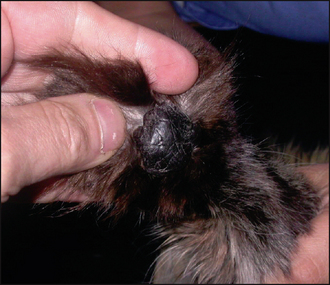54 Feline plasma cell pododermatitis
CASE HISTORY
The history in this case was as follows:
CLINICAL EXAMINATION
The characteristic clinical feature of feline plasma cell pododermatitis is soft spongy swelling of multiple footpads. The central tarsal and carpal pads are most frequently affected. The pads often have what is described as a violaceous hue and are cross-hatched with white striae (Fig. 54.1). Initially, the condition is asymptomatic but ulceration may develop in some cases, leading to lameness and sometimes copious haemorrhage. In very long-standing cases where there has been marked footpad ulceration, large masses of granulation tissue may protrude from the ulcerated surface of the footpad. Occasionally, cats may present with concurrent plasma cell stomatitis, manifested by bilateral, proliferative, ulcerated lesions over the palatopharyngeal arches. Swelling over the bridge of the nose and nasal planum due to a plasma cell infiltrate, concurrent immune-mediated glomerulonephritis and renal amyloidosis have also been described.
The clinical signs in this case were:
Stay updated, free articles. Join our Telegram channel

Full access? Get Clinical Tree



